Research
Laser Development & Operation
Research Overview
Ultra-intense lasers have been utilized for conducting scientific research on relativistic laser-matter interaction and strong-field quantum electrodynamics (QED). In CoReLS, a 0.1-Hz 4-PW Ti:sapphire laser has been actively operated. The spatiotemporal quality of the 4-PW laser is the most important parameter which widens its applicable scope and raises the research quality. Thus, its wavefront correction is optimized and stabilized using an adaptive optics system composed of two deformable mirrors with a feed-back loop, resulting in the world’s highest intensity of 1.1×10²³ W/cm². And its temporal contrast is enhanced by using an OPCPA pre-amplifier, a cross-polarized wave generation technique and a double plasma mirror technique, resulting in the high temporal contrast better than 1012 up to a few picoseconds before the main pulse. For experimental demonstration of nonlinear Compton scattering in the strong-field QED regime, the spatiotemporal synchronization of two ultra-intense laser pulses from the 4-PW laser is implemented using spatial and spectral interferometries. In addition, a 5-Hz 150-TW laser has been also actively utilized to explore several laser-matter interactions and to conduct preliminary experiments of large-scale experimental campaigns using the 4-PW laser.
-
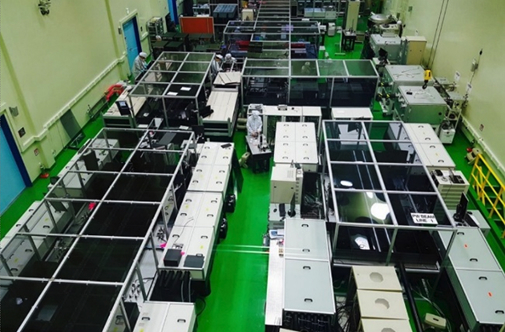
0.1-Hz 4-PW Ti:sapphire Laser
-
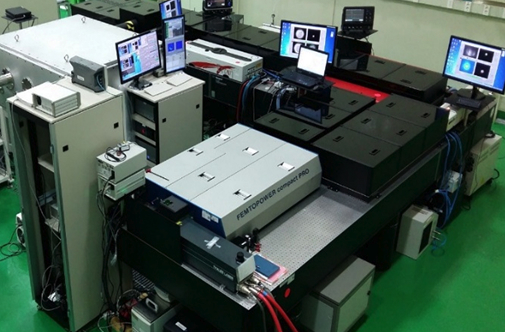
5-Hz 150-TW Ti:sapphire Laser
Research topics
- Stable operation of multi-PW laser
- Enhancement of temporal contrast of multi-PW laser (>1012:1)
- Achievement of ultra-high laser intensity (> 1023 W/cm2)
Research Overview
Achievement of short pulse duration (< 20 fs)
A short pulse duration is necessary to achieve an ultra-high peak power. Two key techniques have been utilized to obtain an ultra-short pulse in the 4-PW laser. Firstly, a cross-polarized wave (XPW) generation technique has been applied after the frontend amplifier to broaden the pulse spectrum through a third-order nonlinear optical effect. Secondly, an OPCPA amplifier which is a nonlinear amplification stage with a broadband gain spectrum was installed as a pre-amplifier of the 4-PW laser. The laser pulse with a broad spectrum was amplified through the OPCPA pre-amplifier after the pulse stretcher, and its spectrum was well maintained by minimizing the gain narrowing effect during amplification. Moreover, the gain depletion effect in subsequent amplifiers could be compensated for by shaping the output spectrum of the OPCPA pre-amplifier, resulting in a final spectral width of 80 nm (FWHM) supporting a 17-fs duration.
-
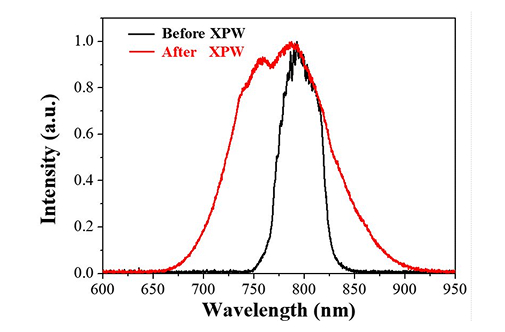
Spectral broadening by XPW
-
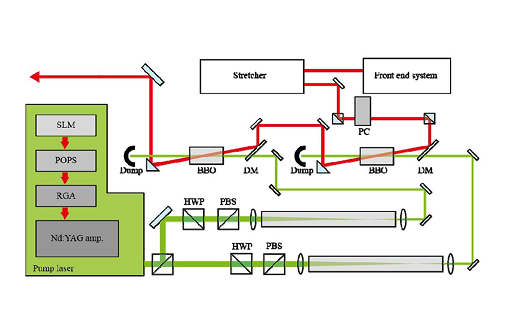
OPCPA pre-amplifier of the 4-PW laser
-
Demonstration of the world’s shortest duration in PW lasers: Opt. Express 26, 24775 (2018)
Enhancement of temporal contrast
A high temporal contrast in an ultra-intense laser is a crucial parameter for investigating relativistic laser-matter interactions. When exposed to laser pulses with intensities exceeding 1010 W/cm², a metal target begins to dissolve and evaporate. Generally, pre-pulses and a pedestal of amplified spontaneous emission (ASE) accompany with the ultra-intense laser pulse, and their intensities can be high enough to create a premature formation of a expanding plasma before the arrival of the main pulse. This premature plasma formation can significantly alter the target conditions, thereby affecting the intended interaction dynamics. To eliminate or suppress pre-pulses and ASE, two key techniques were employed: cross-polarized wave (XPW) generation and the double plasma mirror (DPM) technique. Because the intensity of the XPW signal has a cubic dependence with respect to the signal intensity, pre-pulses and the pedestal with relatively low intensities are suppressed. And the DPM system suppresses the pre-pulses and the pedestal by injecting the laser pulse into two anti-reflection-coated mirrors. The pre-pulses and the pedestal with low intensities penetrates the mirrors while the main pulse is reflected through a plasma generated by the leading edge of the main pulse on the mirror surface. As a result, the relativistic laser-material interactions using the high-contrast ultra-intense pulse can be explored without a severe modification of the target condition.
-
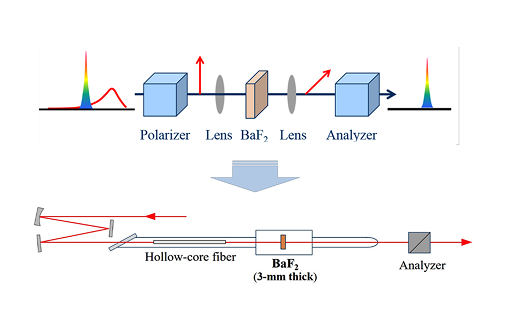
Setup for XPW
-
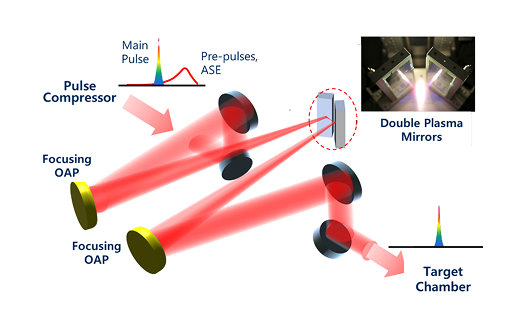
Setup for double plasma mirror
-
Demonstration of ultrahigh-contrast multi-PW laser: Optics Letters 45, 6342 (2020)
Achievement of ultra-high laser intensity
An ultra-high laser intensity can be achieved by minimizing wavefront distortion and tightly focusing the laser beam. The distorted wavefront degrades the focusing ability of the laser beam, preventing the formation of a minimum focal spot. To correct the wavefront distortion, two adaptive optics systems composed of two wavefront sensors and two deformable mirrors were installed before and after the pulse compressor. The wavefront error was minimized by compensating for the measured wavefront error using the deformable mirror. The wavefront-corrected laser pulse was then tightly focused using an f/1.1(f= 300 mm) off-axis parabolic mirror, resulting in a near diffraction-limited spot size of 1.1 μm (FWHM) and a peak intensity of 1.1x1023 W/cm², which is the highest laser intensity recorded to date.
-
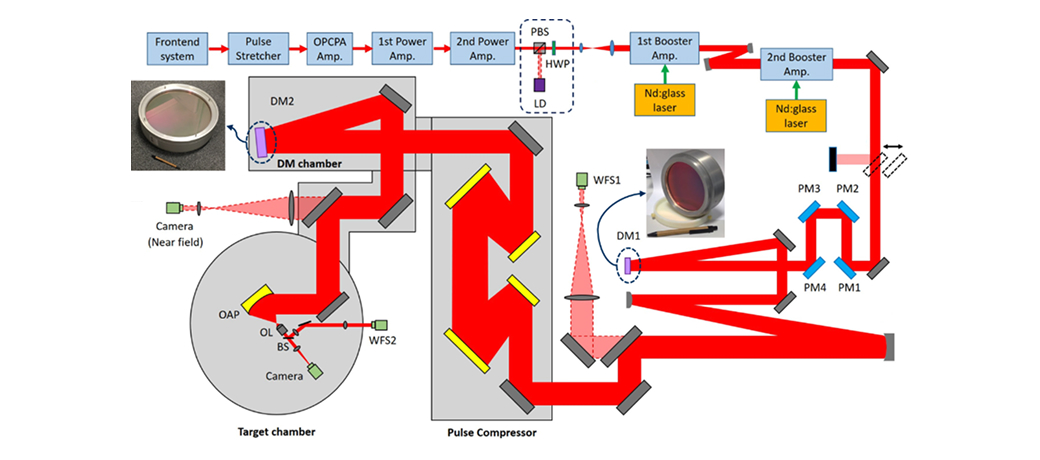
Layout of double adaptive optics systems
-
Demonstration of the world’s highest laser intensity: Optica 5, 630 (2021)
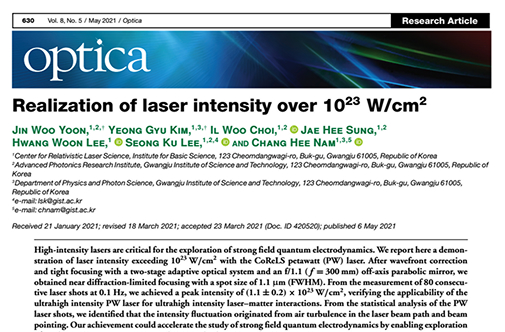
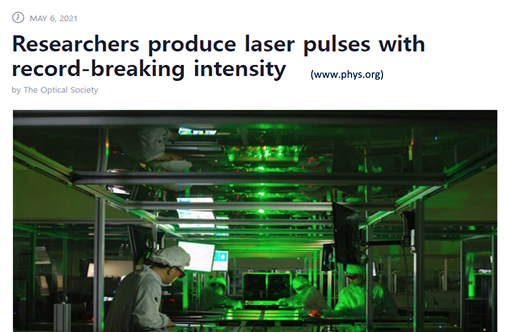
 Center for
Center for